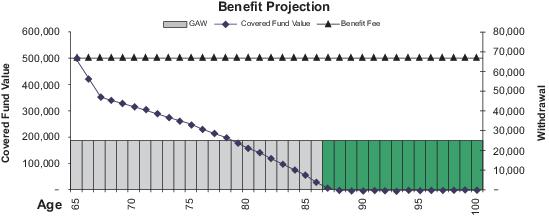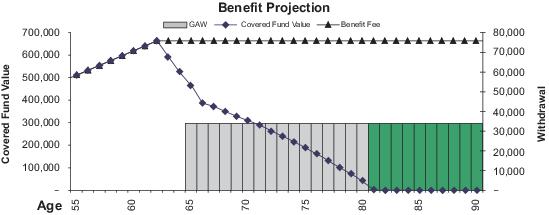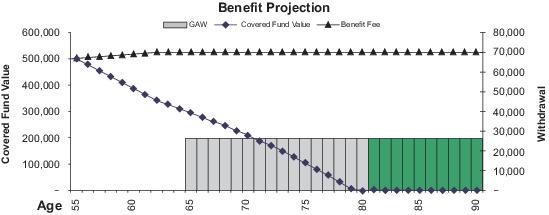Subsequent Contract Contributions to Your Account
During the Accumulation Phase, the GLWB Participant may make additional Contract Contributions to the Covered Funds in addition to the initial Contract Contribution. Subject to the requirements of federal tax law and the terms of the Retirement Plan, subsequent Contract Contributions can be made by cash deposit, Transfers, or rollovers from certain other retirement accounts. Additional Contract Contributions may not be made after the Accumulation Phase ends.
All additional Contract Contributions made after the Election Date will increase the Benefit Base dollar-for-dollar on the date the Contract Contribution is made. We will not consider the additional purchase of shares of a Covered Fund through reinvested dividends, capital gains, and/or settlements to be a Contract Contribution. However, they will increase the Covered Fund Value.
Great-West reserves the right to refuse additional Contract Contributions at any time and for any reason. Exercising this right may limit your ability to increase your Benefit Base by making additional Contract Contributions. If Great-West refuses additional Contract Contributions, the GLWB Participant will retain all other rights under the GLWB.
Ratchet Date Adjustments to the Benefit Base
During the Accumulation Phase, the Benefit Base will be evaluated and, if necessary, adjusted on an annual basis. This is known as the Ratchet Date and it occurs on the anniversary of the Election Date. It is important to be aware that even though the GLWB Participant's Covered Fund Value may increase throughout the year due to dividends, capital gains, or settlements from the underlying Covered Fund, the Benefit Base will not similarly increase until the next Ratchet Date. Unlike Covered Fund Value, the GLWB Participant's Benefit Base will never decrease solely due to negative Covered Fund performance.
On each Ratchet Date during the Accumulation Phase, the Benefit Base is automatically adjusted (“ratcheted”) to thegreater of:
| (a) | the current Benefit Base; or |
| (b) | the current Covered Fund Value. |
Example of Ratchet Date Adjustments during the Accumulation Period
Assume the following:
Benefit Base on Election Date (of January 2) = $100,000
Covered Fund Value on Election Date = $100,000
Increase in Covered Fund Value due to Dividends and Capital Gains paid July 1 = $5,000
Covered Fund Value on July 1 = $105,000
Benefit Base on July 1 = $100,000
No other Contract Contributions, Dividends, or Capital Gains are paid for the rest of the year.
Covered Fund Value on January 2 of the following year = $105,000
So, because the Covered Fund Value is greater than the Benefit Base on the Ratchet Date (January 2 of the following year), the Benefit Base is adjusted to $105,000 effective January 2.
Excess Withdrawals During the Accumulation Phase
Because the GLWB is held in the Account, the GLWB Participant may make withdrawals or change the GLWB Participant’s Account investments at any time and in any amount that the GLWB Participant wishes, subject to any federal tax limitations or Retirement Plan limitations. During the Accumulation Phase, however, any withdrawals or Transfers from the GLWB Participant’s Covered Fund Value will be categorized as Excess Withdrawals. Any withdrawals to satisfy the GLWB Participant’s required distribution obligations under the Code will be considered an Excess Withdrawal if taken during the Accumulation Phase.
The GLWB Participant should carefully consider the effect of an Excess Withdrawal on both the Benefit Base and the Covered Fund Value during the Accumulation Phase, as this may affect the GLWB Participant’s future benefits under the Contract. In the event the GLWB Participant decides to take an Excess Withdrawal, as discussed below, the GLWB Participant’s Covered Fund Value will be reduced dollar-for-dollar in the amount of the Excess Withdrawal. The Benefit Base will be reduced at the time the Excess Withdrawal is made by the ratio of the Covered Fund Value after the Excess Withdrawal reduction is applied.
Accordingly, the GLWB Participant’s Benefit Base will be reduced by more than the amount of the withdrawal when the Benefit Base is greater than the Covered Fund Value, which is likely to occur after periods of negative market performance.


